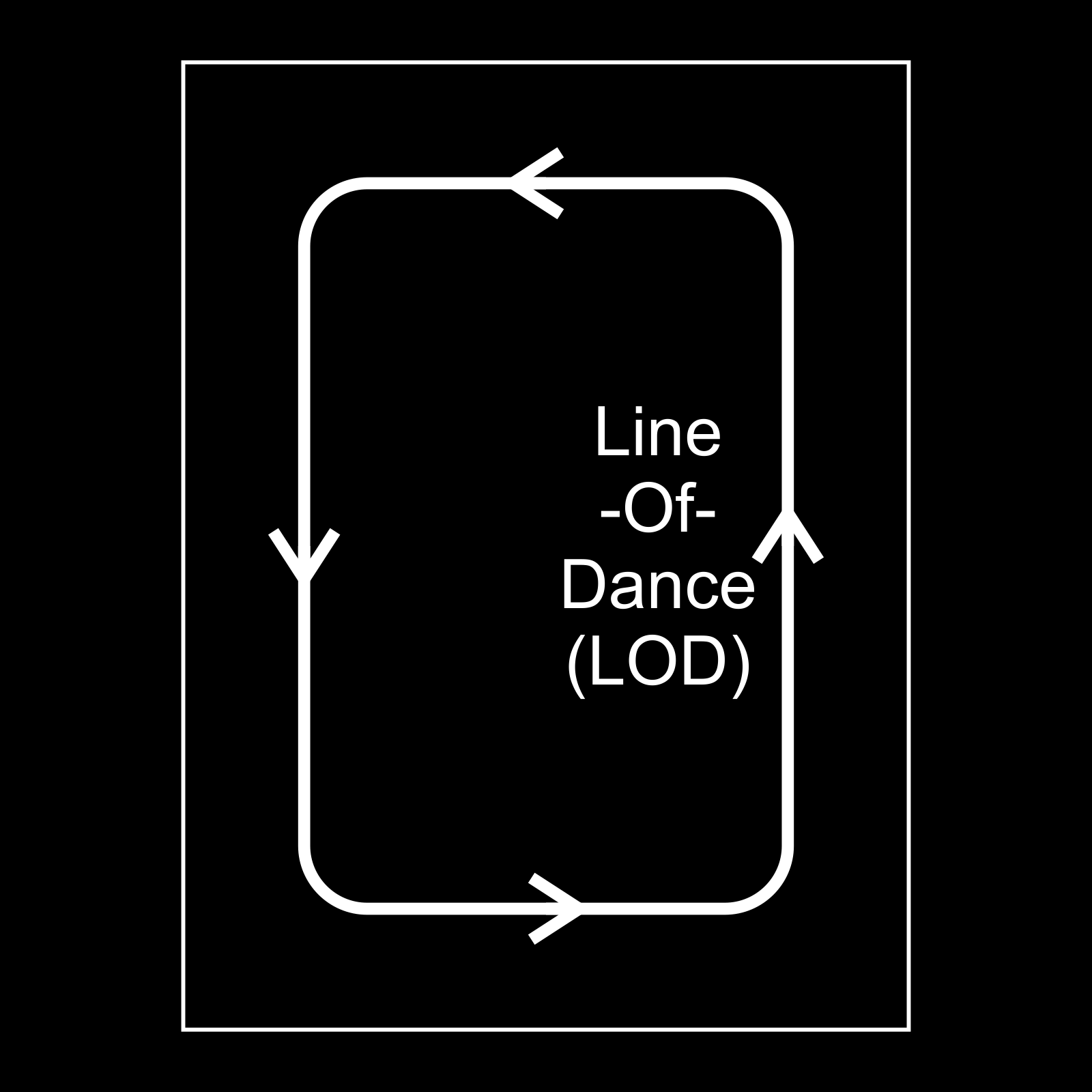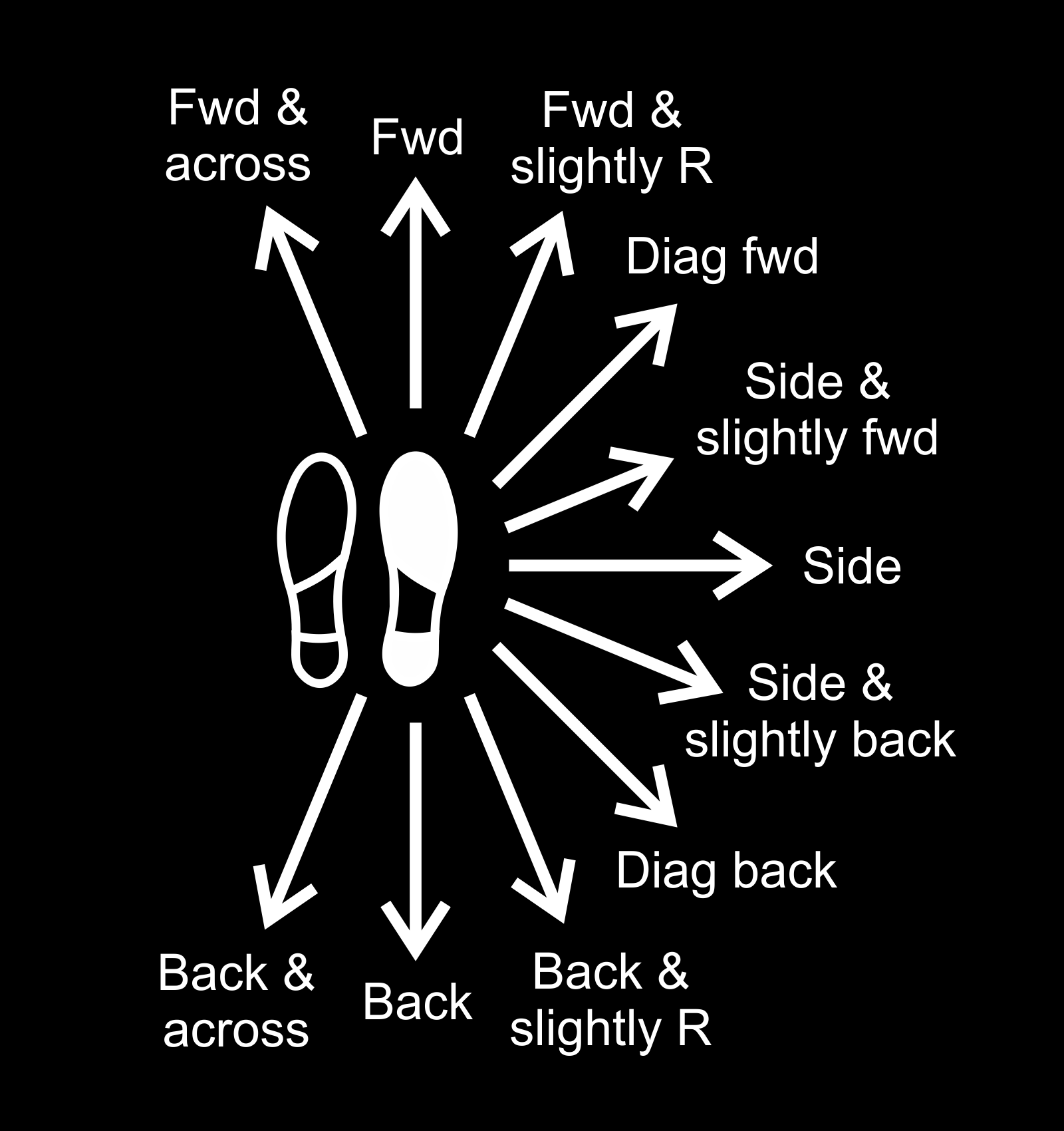

17: Dance Notation
To communicate about dance, and more particularly to commit it to paper for posterity, requires a method of notation – a short-hand, if you like, a set of abbreviations or symbols with an agreed interpretation. You’ll find these set out in any book on ballroom dancing, but for convenience and easy reference I’ll summarise the main notation here.
Alignments
By “alignment”, we mean which way you are facing, and we use the dancing equivalent of compass points. The cardinal compass point is Line-Of-Dance (“LOD”), which means the normal anti-clockwise circulation around the dance floor. The outer rectangle in the diagram below represents the edges of the dance floor:

When a figure (ie a defined set of steps) dances into and out of a corner, the direction of LOD changes (because of the corner), and is called the “new LOD” (subsequently becoming just “LOD” again).
Very rarely are we dancing just along the LOD. That would be decidedly boring, and makes floor-craft difficult to impossible. Usually we zig-zag on diagonals, as you will find if you look up the technical descriptions of (or are taught) the various figures. Neither do proper figures often move directly towards or away from the edge of the floor: those would make no progress around the floor and act as road blocks for other dancers.
The diagram and table below shows the alignments relative to LOD, and their notation:

| LOD | Line-Of-Dance: The normal direction of travel around the ballroom (see description above). |
| C | Centre: The direction at a right-angle to LOD, towards the centre of the dance floor. |
| W | Wall: The direction at a right-angle to LOD, towards the edge of the dance floor. |
| DC | Diag. to Centre: The diagonal direction between LOD and C. |
| DW | Diag. to Wall: The diagonal direction between LOD and W. |
| Against LOD | When the direction is against the normal progression around the dance floor. |
| Backing | When the dancer is facing in one direction but moving in the opposite direction, this is referred to as “backing”. For example: “backing DC” means facing DW against LOD, but moving DC. |
| New LOD | Figures danced in a corner go in relative to LOD and come out relative to the “new LOD” (which would previously have been C). |
Normally, the gentleman’s alignment is described and the lady’s alignment is the complement (eg when the gentleman is facing DW, the lady is backing DW or facing DC against LOD). Of course, alignments relative to LOD only apply to the moving dances, and not Cha Cha Cha, Rumba, or Jive.
Step Directions
The direction a step is taken is not measured according to which way the dancer is facing, which could change a lot, but is instead referenced to the standing foot. Note that the standing foot might turn on the heel or ball-of-foot, so that must be taken into account (eg: a step which might be in the forward direction before the standing foot has turned in a spin will end up backwards once the foot has turned).
The diagram below shows the descriptions of step directions for the right foot, relative to the standing left foot. Descriptions for the left foot are the obvious mirror of these. The diagram shows the right foot as it would be in the closed position.

These details seem fussy, but are surprisingly important. Not adhering to the correct alignments and step directions are frequently the reason figures go wrong, because although the gentleman might think it works for him, that does not ensure the lady has an easy time following! Gents: it’s all about getting your lady around the floor, not what you can do regardless of your lady.
Use of Foot and Body
An (incomplete) run-down of terms used to describe how the body and footwork are used to achieve any particular dance figure:
| R, RF | Right, Right Foot. |
| L, LF | Left, Left Foot. |
| T | Toe: The step is on the toe (heel does not contact the floor). |
| H | Heel: The step is taken on the heel, but eventually the whole foot. |
| HT | Heel-Toe: Landing heel, but rolling through to toe (heel off the floor). |
| TH | Toe-Heel: Going backwards, rolling across the toe onto the heel. |
| Nat. | Natural: A right-turning figure. These are “natural” because the dancing position with the gentleman’s left foot clear of the lady makes rightward turns comfortable, and also plays into the anti-clockwise progression around the dance floor. |
| Rev. | Reverse: A left-turning figure (opposite of Natural). |
| Closed | The feet come together at the end of the figure. |
| Open | The feet are not together at the end of the figure, eg Open Telemark which ends in PP. |
| OP | Outside Partner: Normally, forward steps on the right foot are taken to your right of your partner’s right foot. OP is right foot to the left of partner’s right foot, or left foot to right of partner’s left foot. |
| In Line | “In Line” is the converse of Outside Partner, and does not usually need to be specified (it’s the normal step). |
| PP | Promenade Position: Partners in hold, but gentleman facing left and lady facing right (same direction). |
| CBM | Contra Body Movement: Shoulders lead the opposite of the feet. Body rotation is the key to leading the lady through turns. |
| CBMP | Contra Body Movement Position: Keeping an opposite twist through the shoulders is the key to steps OP or across (see above). |
Timing
The notation for timing varies according to what seems appropriate for the particular dance. Waltz, for example, is counted “1 2 3”, whereas Foxtrot and Quickstep tend to be counted in slows and quicks.
| Q | Quick: Typically one beat of music. |
| S | Slow: Typically two beats of music. |
| & | “And”: A syncopation, pinching half a beat of music from the previous count. |
| (Q), (S) | Counts in parentheses (brackets) indicate a count without a change of weight, ie danced on the same foot – typically a drag of the foot without weight, or a shape change through the body. |
| a- | “a”: Used in Samba notation to indicate a timing split shorter than would be implied by “&”. |